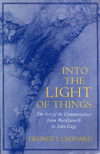Book Review
INTO THE LIGHT OF THINGS: THE ART OF THE COMMONPLACE FROM WORDSWORTH TO JOHN CAGE (an original theory of the avant garde, published by the University of Chicago Press).
A New Framework of Thought on Modern Art
Into the Light of Things
Reviewed by Kenneth Baker
In 1981, philosopher Arthur Danto added a durable new anecdote to the lore that lends color to theories of modern art. In a book called The Transfiguration of the Commonplace, he recounted his experience of seeing for the first time in a New Yorker gallery Andy Warhol's 1964 Brillo Boxes, ordinary, stacked-up cardboard boxes, silk-screened to look just like cases of Brillo soap pads.
Warhol's proposition that objects offered and accepted as art now might be indistinguishable from mere real things caused Danto to rethink completely his understanding of modern art. It seemed to him that with Warhol, art had come to an end in some sense.
George J. Leonard, professor of humanities at San Francisco State University, borrows Danto's story to launch in Into the Light of Things a new interpretation of modern art's gradual sinking into the background of the commonplace.
Accepted critical wisdom traces Warhol's pop art (and other low-definition 60s art) to the early art pranks of Marcel Duchamp. Art historians have a tendency to see the influence of modern French art as paramount because of its overwhelming prestige on both sides of the Atlantic between 1850 and 1940.
Leonard reframes the issue completely. He finds in English Romantic poetry and American Transcendentalist thought a more illuminating lineage for postwar American art's gradual demotion of artworks from elite objects to stuff distinguished from the background of ordinary life only in the attention paid to it. "Attacks on the art object strikingly similar to those made at the so-called end of art," Leonard argues, "can be found in the works of Wordsworth, Ruskin, Carlyle, Emerson and Whitman. Many of these attacks are as scathing as any the sixties concept artists ever made. If they are unfamiliar to the modern reader, that is because they were indeed so scathing, that criticism has avoided them as anomalies. Until the late sixties, it was hard to believe artists, cultivated people, could seriously have meant such attacks on art." Leonard asks again what was it that ended around the time when Danto and others began wondering whether art had expired. His answer is startling: What ended was the art object's service to a modern tendency in Western spirituality that literary critic M.H. Abrams named "Natural Supernaturalism."
This belief is the faith that the most mundane realities are as suffused with the divine, or the miraculous, as the most exalted works of humanity (namely, artworks). Art, Leonard argues, was the arena in which, for 150 years or so, this mystic sense of the ordinary contended with other notions of how things and which things can communicate spiritual values.
Since 1800, Leonard writes "the primary aestheticians have not been the philosophers trying to define art but the artists/aestheticians relentlessly expanding. . . every proposed definition. Definitions of what art is changed rapidly during the twentieth century," Leonard notes, as theorists, "watching the circle spread to include more and more that had not been art, ventured that art's limit must be artwork with significant form; then any artwork that expressed a feeling; then not an artwork but an art object, dignified by the artist's election; then any random object at all; then, not even an object.
Through discussions of Wordsworth, Ruskin, Carlyle and, most extensively, John Cage, Leonard shows that modern art's bouts of self-assertion and self-effacement have primarily not been about art at all but about Natural Supernaturalism's dissemination into popular awareness. John Cage presided over so much of the liberation from the art object and then from the art world that his career is a capsule history of the whole process.
Leonard's book is a fine example of interdisciplinary studies. He shifts focus persuasively from art theory to literature to religious thought and biography, making his method seem the natural mode of inquiry into culture.
In its agility and sweep, Leonard's approach necessarily neglects some levels of detail. His view of Cage's life's work, for example is balanced and skeptical, especially in his account of the Zen thinking that Cage learned from Daisetz T. Suzuki. But, although Leonard quotes Cage well, he never discusses his own experience of Cage's work, which is a key test of Cage's ideas.
Further, Leonard's cross-disciplinary approach requires him to whistle past questions of one artistic medium's differences from another. Natural Supernaturalism may be exuded by Minimal sculpture, Cage's music and language poetry alike, but are the experiences they offer really on a common plane?
.....[It goes to show] how much there is to say about Cage's output whether you accept it as art, activism, philosophy, literature or even chicanery.
